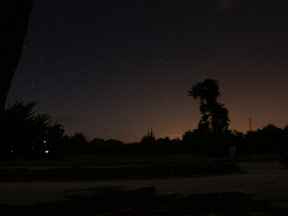My Observations of the Stardust Comet Probe Re-entry
Jan 15, 2006
Well - it was disappointing. I drove up Old San Jose Road intending to meet
Karl at Mt. Bache Rd hogback, but the higher I got, the more ground fog enveloped
me. At 1:11am I figured if I didn't turn around soon, I'd run out of time. The
sky looked good from home, so I decided to turn around and head back and set
up at Lighthouse Park, where there's a good northern horizon free of streetlights.
I arrived at "dog beach" parking lot just west of the lighthouse,
but didn't have time to set up the videocamera. I did set up the Dimage 5 digital
camera on a tripod, found good photo parameters, and waited the last 4 minutes
till the event. Then, 1 minute before re-entry, someone parked and ran up to
me who turned out to be the cousin of the mission controller at JPL for the
Stardust mission! Kinda cool, but she was way too excited and I couldn't seem
to impress on her that there was plenty of time to talk LATER! now was time
to leave me alone to find this thing and photograph it. So I was pretty distracted
and if it was like a faint star, I could've missed it. However it was clear
enough to see Cassiopeia where re-entry began, and Alpha Cephei which it was
predicted to pass right over (but Alpha Cephei could only be seen in binoculars,
and it's 2nd magnitude, so apparently a lot of exctinction in the wet air).
But in the end, I saw nothing. Neither did at least one other Bay Area observer,
from Martinez. Peak magnitude was supposed to be -7, a dozen times brighter
than Venus. But clearly that must be distance-dependent. Let me calculate here....
if that was for an observer near the path, say 200 miles away from it, and I
was 500 miles away that would translate to 2.0 magnitudes dimmer or m=-5; still
as bright as Venus and quite easy to see. Even if only m=1 I should've seen
it with the naked eye so.... I have no explanation. The mission went very well
and was right on predicted tragectory - I'm watching NASA TV as I write this.
OK, now I found a description from someone else in the Bay Area who did see
it...
"1:58 PST, Lafayette, CA (visual), W Sanders, Comments: I saw it - just
barely! I started intently in the region of Cassiopeia, which I could just make
out in the moon glow and urban haze (I could not see the Little Dipper.) It
never appeared there. At about 11:58 I looked further east and just made it
out for about 10 seconds as it scooted fast about 5 degrees above the NE horizon
where I have an unobstructed but light-polluted view. It was fast! Much faster
than a normal satellite but slower than a natural meteor. It had a reddish color,
maybe because it was so low down on the horizon, and varied in brightness a
little. At one point it appeared pure red for an instant. Magnitude about 3
or so, a little dimmer than Polaris for the few seconds I saw it." and
here's some other links on the observations...Jim Albers' (LMCO) Stardust Rentry
page, has dozens of visual sightings (mostly from Northern California) and some
photos taken from the ground. http://dgilbert3.home.mindspring.com/stardust.htm
Here is where to report your visual sightings, images or video if you know
anyone who had viewing luck this morning http://reentry.arc.nasa.gov/registrationobservations.html
So. Mag 3 I could've missed, and if it didn't brighten until much further east
in it's path, it could've been clouded out or perhaps passed below the Santa
Cruz Mountains ridge. Certainly Cassiopeia was visible, but due north Alpha
Cephei was 2nd magnitude and only visible in binoculars. Then there was a cypress
tree, and farther east than that I didn't recall seeing much in the way of stars.
And magnitude 3 doesn't sound like the spectacle I was hoping for. It would've
been more useful if the main website for requesting these observations had had
a better prediction of where you'd have to be to see m=-7 and where along the
path the brightness would be maximum. Here's
a picture from Peter Jennisken's group on the DC8 airplane from somewhere
in Nevada or Utah.
 Feb
14: I'm finally taking a look at the one digital picture I took during
the time of the re-entry. Maybe I did in fact capture something, although it's
a lot lower in the sky than I was expecting. Is that 3rd magnitude trail near
the tree line the Stardust re-entry?
Feb
14: I'm finally taking a look at the one digital picture I took during
the time of the re-entry. Maybe I did in fact capture something, although it's
a lot lower in the sky than I was expecting. Is that 3rd magnitude trail near
the tree line the Stardust re-entry?
 Feb
14: I'm finally taking a look at the one digital picture I took during
the time of the re-entry. Maybe I did in fact capture something, although it's
a lot lower in the sky than I was expecting. Is that 3rd magnitude trail near
the tree line the Stardust re-entry?
Feb
14: I'm finally taking a look at the one digital picture I took during
the time of the re-entry. Maybe I did in fact capture something, although it's
a lot lower in the sky than I was expecting. Is that 3rd magnitude trail near
the tree line the Stardust re-entry?